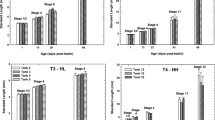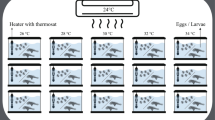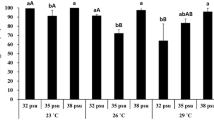Abstract
Three embryonic stages of Atlantic salmon (Salmo salar L.) were subjected to eight constant incubation temperatures (4, 7, 10, 12, 14, 16, 19 and 22 °C) exceeding the range usually experienced in natural conditions. A change in thermal tolerance during the embryonic and larval development was registered: pre-hatching stages showed an upper thermal limit at about 16 °C, while hatched larvae survived until 22 °C. Temperature significantly affects developmental rate, resulting in a faster development and, consequently, lower yolk weight percentage at higher temperatures. We found positive relationships between incubation temperature and body size (length and weight) in the less developed stages, in which some yolk remained, but size decreased at increasing temperatures when yolk was completely exhausted.
Similar content being viewed by others
References
Alderdice, D.F. and Velsen, F.P.J. 1978. Relationship between temperature and incubation time for eggs of chinook salmon (Oncorhynchus tshawytscha). Journal of the Fisheries Research Board of Canada 35: 69–75.
Baynes, S.M. and Howell, B.R. 1996. The influence of egg size and incubation temperature on the condition of the Solea solea (L.) larvae at hatching and first feeding. Journal of Experimental Marine Biology and Ecology 199: 59–77.
Beacham, T.D. and Murray, C.B. 1990. Temperature, egg size, and development of embryos and alevins of five species of Pacific salmon: a comparative analysis. Transactions of the American Fisheries Society 119: 927–945.
Blaxter, J.H.S. 1992. The effect of temperature on larval fishes. Netherlands Journal of Zoology 42: 336–357.
Brännäs, E. 1987. Influence of photoperiod and temperature on hatching and emergence of Baltic salmon (Salmo salar L.). Canadian Journal of Zoology 65: 1503–1508.
Brett, J.R. 1970. 3. Temperature. 3.3. Animals. 3.3.2. Fishes. In: Marine Ecology (ed. O. Kinne), Vol. 1, Pt 1, pp. 515–573. Wiley Interscience, London.
Crisp, D.T. 1988. Prediction from temperature of eyeing, hatching and 'swim-up' times for salmonid embryos. Freshwater Biology 19: 41–48.
Gorodilov, Yu N. 1983. Stages of embryonic development in Atlantic salmon, Salmo salar L. II. Description and chronology. Translated by J.E. Thorpe of: Stadii embyronalnogo razvitiya Atlanticheskogo lososya Salmo salar L. II. Opisaniye i khronologiya. Sb. nauchn.tr. GosNIORKh 200, 107–126.
Heggberget, T.G. and Wallace, J.C. 1984. Incubation of the eggs of Atlantic salmon, Salmo salar, at low temperatures. Canadian Journal of Fisheries and Aquatic Sciences 41: 389–391.
Heming, T.A. 1982. Effects of temperature on utilisation of yolk by chinook salmon (Oncorhynchus tshawytscha) eggs and alevins. Canadian Journal of Fisheries and Aquatic Sciences 39: 184–190.
Heming, T.A. and Buddington, R.K. 1988. Yolk absorption in embryonic and larval fishes. In: Fish Physiology (eds S. Hoar and D.J. Randall), Vol. XIA: pp. 407–446. Academic Press, San Diego.
Hodson, P.V. and Blunt, B.R. 1986. The effect of time from hatch on the yolk conversion efficiency of rainbow trout, Salmo gairdneri, Journal of Fish Biology 29: 37–46.
Jensen, A.J., Johnsen, B.O. and Saksgård, L. 1989. Temperature requirements in Atlantic salmon (Salmo salar), brown trout (Salmo trutta), and Arctic char (Salvelinus alpinus) from hatching to initial feeding compared with geographic distribution. Canadian Journal of Fisheries and Aquatic Sciences 46: 786–789.
Kamler, E. 1992. Early Life History of Fish: an Energetics Approach, 255 pp. Chapman and Hall, London.
Kane, T.R. 1988. Relationship of temperature and time of initial feeding of Atlantic salmon. The Progressive Fish-Culturist 50: 93–97.
Marr, D.H.A. 1966. Influence of temperature on the efficiency of growth of salmonid embryos. Nature 212: 957–959.
Peterson, R.H. and Martin-Robichaud, D.J. 1995. Yolk utilization by Atlantic salmon (Salmo salar L.) alevins in response to temperature and substrate. Aquacultural Engineering 14: 85–99.
Peterson, R.H., Martin-Robichaud, D.J. and Berge, Å. 1996. Influence of temperature and salinity on length and yolk utilisation of striped bass larvae. Aquaculture International 4: 89–103.
Peterson, R.H., Spinney, H.C.E. and Sreedharan, A. 1977. Development of Atlantic salmon (Salmo salar) eggs and alevins under varied temperature regimes. Journal of the Fisheries Research Board of Canada 34: 31–43.
Rombough, P.J. 1988. Respiratory gas exchange, aerobic metabolism, and effects of hypoxia during early life. In Fish Physiology (eds S. Hoar and D.J. Randall) Vol. XIA, pp. 59–61. Academic Press, San Diego.
Rombough, P.J. 1994. Energy partioning during fish development: additive or compensatory allocation of energy to support growth? Functional Ecology 8: 178–186.
Author information
Authors and Affiliations
Corresponding author
Rights and permissions
About this article
Cite this article
Ojanguren, A.F., Reyes-Gavilán, F.G. & Muñoz, R.R. Effects of Temperature on Growth and Efficiency of Yolk Utilisation in Eggs and Pre-feeding Larval Stages of Atlantic Salmon. Aquaculture International 7, 81–87 (1999). https://doi.org/10.1023/A:1009214804949
Issue Date:
DOI: https://doi.org/10.1023/A:1009214804949




